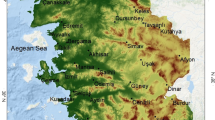Abstract
It is theoretically interesting for climate change detection and practically important for agricultural producers to know whether climate change has influenced agroclimatic conditions and, if so, what the potential impacts are. We present analyses on statistical differences in means and variances of agroclimatic indices between three 30-year periods in the 20th century (i.e., 1911–1940, 1941–1970 and 1971–2000). We found many occurrences of statistically significant changes in means between pairs of the three 30-year periods. The findings consistently support agroclimatic trends identified from trend analysis as an earlier growing season start and an earlier end to spring frost (SF), together with an extended growing season, more frost-free days (FFD) and more available heat units were often found in the later 30-year periods as compared to the earlier ones. In addition, this study provides more detailed quantitative information than the trend signals for the practical interests of agricultural applications. Significant changes were detected for SF and FFD at a much larger percentage of stations between the latter two 30-year periods (1941–1970 vs. 1971–2000) as compared to the earlier two periods (1911–1940 vs. 1941–1970). In contrast, changes in variances of the selected agroclimatic indices were less evident than changes in their means, based on the percentage of stations showing significant differences. We also present new climate averages of the selected agroclimatic indices that can be useful for agricultural planning and management.





Similar content being viewed by others
References
Agronomic Interpretations Working Group (1995) Land suitability rating system for agricultural crops: 1. Spring-seeded small grains. In: Pettapiece WW (ed) Tech. Bull. 1995-6E. Centre for Land and Biological Resources Research, Agriculture and Agri-Food Canada, Ottawa, 90 Pages, 2 maps
Benjamini Y, Hochberg Y (1995) Controlling the false discovery rate: a practical and powerful approach to multiple testing. J Roy Stat Soc B 57:289–300
Bonsal BR, Zhang X, Vincent LA, Hogg WD (2001) Characteristics of daily and extreme temperatures over Canada. J Clim 14:1923–1936
Bootsma A (1994) Long term (100 yr) climatic trends for agriculture at selected locations in Canada. Clim Change 26:65–88
Bootsma A, Gameda S, McKenney DW (2005a) Impacts of potential climate change on selected agroclimatic indices in Atlantic Canada. Can J Soil Sci 85:329–343
Bootsma A, Gameda S, McKenney DW (2005b) Potential impacts of climate change on corn, soybeans and barley yields in Atlantic Canada. Can J Soil Sci 85:345–357
Brown DM, Bootsma A (1993) Crop heat units for corn and other warm season crops in Ontario. Ontario Ministry of Agriculture and Food Factsheet 93–119, Agdex 111/31, 4 pp. [Available online at http://www.omafra.gov.on.ca/english/crops/facts/93-119.htm]
IPCC (2007) In: Core Writing Team, Pachauri RK, Reisinger A (eds) Climate change 2007: synthesis report. Contribution of working groups I, II and III to the fourth assessment report of the intergovernmental panel on climate change. IPCC, Geneva, p 104
Jones JW, Hoogenboom G, Porter CH, Boote KJ, Batchelor WD, Hunt LA, Wilkens PW, Singh U, Gijsman AJ, Ritchie JT (2003) The DSSAT cropping system model. Eur J Agron 18:35–265
Jones JW, Tsuji GY, Hoogenboom G, Hunt LA, Thornton PK, Wilkens PW, Imamura DW, Bowen WT, Singh U (1998) Decision support system for agrotechnology transfer; DSSAT v3. In: Tsuji GY, Hoogenboom G, Thornton PK (eds) Understanding options for agricultural production. Kluwer Academic 486 Publishers, Dordrecht, pp 157–177
Mekis E, Hogg WD (1999) Rehabilitation and analysis of Canadian daily precipitation time series. Atmosphere-Ocean 37:53–85
Montandon LM, Fall S, Pielke RA Sr, Niyogi D (2011) Distribution of landscape types in the global historical climatology network. Earth Interact 15. doi:10.1175/2010EI371.1
Phillips D (1990) The climates of Canada. Environment Canada, Downsview, Ontario, ISBN 0-660-13459-4. pp. 176
Qian B, Gameda S (2010) Canadian agroclimatic scenarios projected from a global climate model. 90th American Meteorological Society Annual Meeting, January 17–21, Atlanta, Georgia. Available online at ams.confex.com/ams/pdfpapers/165170.pdf
Qian B, Hayhoe H, Gameda S (2005a) Developing daily climate scenarios for agricultural impact studies. 85th American Meteorological Society Annual Meeting, January 8–14, 2005, San Diego, California. Available online at ams.confex.com/ams/pdfpapers/83278.pdf
Qian B, Hayhoe H, Gameda S (2005b) Evaluation of the stochastic weather generators LARS-WG and AAFC-WG for climate change impact studies. Clim Res 29:3–21
Qian B, Zhang X, Chen K, Feng Y, O’Brien T (2010) Observed long-term trends for agroclimatic conditions in Canada. J Appl Meteorol Clim 49:604–618
Shabbar A, Bonsal B (2003) An assessment of changes in winter cold and warm spells over Canada. Nat Hazards 29:173–188
Storey JD (2002) A direct approach to false discovery rates. J Roy Stat Soc B 64(part 3):479–498
UK Met Office (2010) Climate averages. http://www.metoffice.gov.uk/climate/uk/averages/
Vincent LA (1998) A technique for the identification of inhomogeneities in Canadian temperature series. J Clim 11:1094–1104
Vincent LA, Gullett DW (1999) Canadian historical and homogeneous temperature datasets for climate change analyses. Int J Climatol 19:1375–1388
Vincent LA, Mekis E (2006) Changes in daily and extreme temperature and precipitation indices for Canada over the twentieth century. Atmosphere-Ocean 44:177–193
Vincent LA, Zhang X, Bonsal BR, Hogg WD (2002) Homogenization of daily temperatures over Canada. J Clim 15:1322–1334
Zhang X, Hogg WD, Mekis E (2001) Spatial and temporal characteristics of heavy precipitation events over Canada. J Clim 14:1923–1936
Zhang X, Vincent LA, Hogg WD, Niitsoo A (2000) Temperature and precipitation trends in Canada during the 20th century. Atmosphere-Ocean 38:395–429
Acknowledgements
We thank Dr. Kai Chen and Feng Yang at Environment Canada for their contribution to the definitions and the calculations of agroclimatic indices used in this study. Three anonymous reviewers and the associate editor are acknowledged for their very helpful comments that improved the manuscript. This is ECORC Contribution No 11-210.
Author information
Authors and Affiliations
Corresponding author
Rights and permissions
About this article
Cite this article
Qian, B., Gameda, S., Zhang, X. et al. Changing growing season observed in Canada. Climatic Change 112, 339–353 (2012). https://doi.org/10.1007/s10584-011-0220-8
Received:
Accepted:
Published:
Issue Date:
DOI: https://doi.org/10.1007/s10584-011-0220-8




